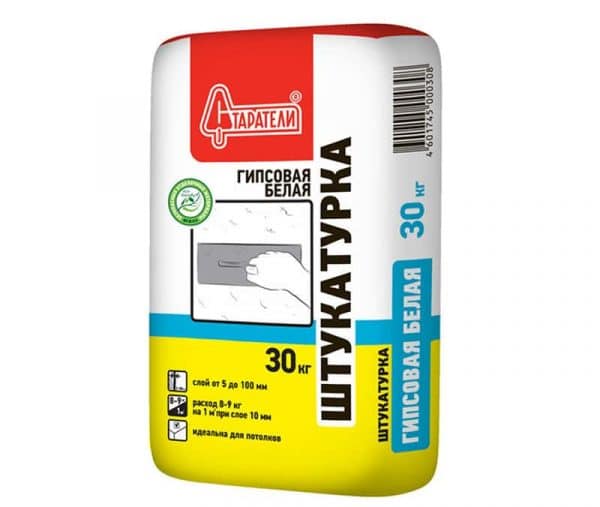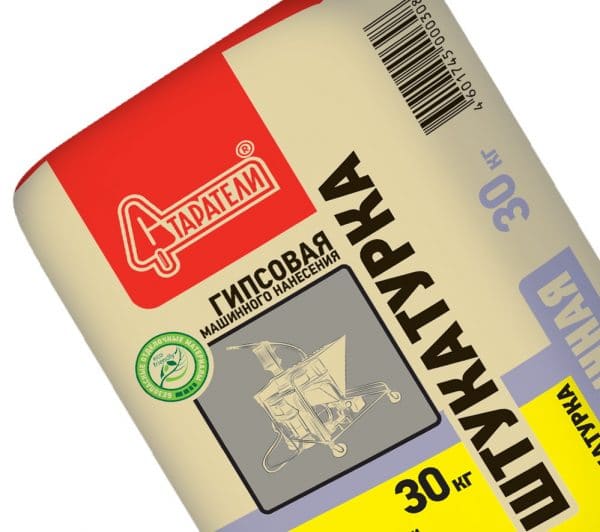Gypsum plaster "Prospectors" is one of the most popular material among professionals. It is ideal for finishing rooms with a normal level of humidity, giving the ceilings and walls evenness, smoothness and eliminates all flaws.
- Material Basics
- Composition and color palette
- Technical characteristics and properties of plaster
- Application technology
- Surface preparation
- Preparation of working solution
- Plastering surfaces
- Manual application
- Mechanical application
- Advantages and disadvantages of plaster
- Material price
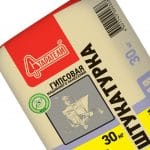
Material Basics
Plaster of the brand "Prospectors" is produced by a well-known domestic manufacturer. Despite the fact that the assortment of the company includes plasters on cement and polymer binders, as well as decorative materials, the most in demand gypsum mixture for internal work is considered.
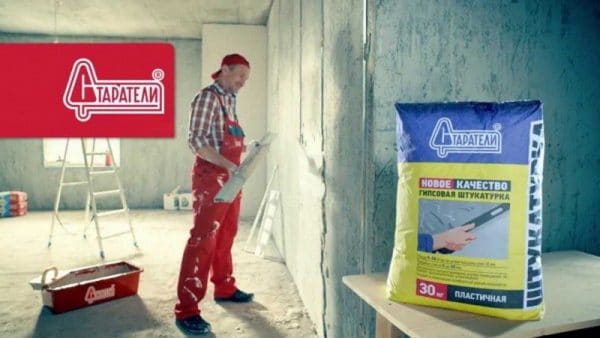
The restriction on the scope of application is due to the fact that gypsum does not tolerate moisture, so mixtures without moisture-resistant additives cannot be applied to surfaces in the bathroom, shower, toilet, or other wet rooms. However, some Prospectors gypsum plasters include special modifiers, which is why they are even suitable for decorating rooms with a high level of humidity.
Plaster is widely used during construction and finishing works when arranging new buildings and private houses. No less well, it is suitable for restoration, repair of any residential, office or public premises. The mortar is suitable for:
- sealing cracks and cracks;
- greasing chips;
- processing ceilings, niches, arches, partitions;
- wall finishes before applying decorative plasters;
- surface treatment before gluing tiles.
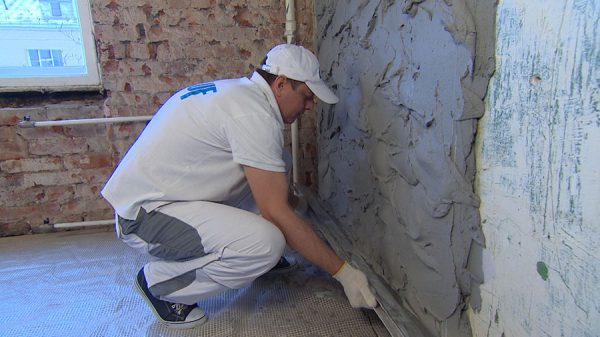
Plaster is ideally suited for walls made of brick, gypsum concrete, concrete and reinforced concrete, aerated concrete, cellular concrete, foam concrete. It fits perfectly on other gypsum and cement plasters. Due to its evenness, fine structure and versatility, the material can be used instead of putty. It is very easy to apply this building mixture, because it is plastic and ductile, therefore it is appreciated by both novice masters and professionals.
to contents ↑Composition and color palette
The basic adhesive component of the plaster is white or gray gypsum - a light but strong mineral material. To optimize properties, the composition of the mixture includes other minerals, fillers, modifiers, plasticizers, additives.
to contents ↑On sale you can find the Prospectors stucco in gray or white, sometimes a pink building mixture is realized, and this shade does not appear due to the introduction of pigment, but due to the special color of natural gypsum. If necessary, the material can be tinted after dilution or mix the powder with dry pigment.
Technical characteristics and properties of plaster
Gypsum plaster "Prospectors" can be applied manually or mechanized. It perfectly fits with a thin and rather thick layer: the main thing is that it be within 5-50 mm. The optimum layer thickness is 15 mm. When using additional reinforcement, the interlayer can be increased even up to 80-100 mm. Subject to the above standards, the plaster will not become cracked, it will not peel off after drying.
The main properties of the stucco mixture are as follows:
- vapor permeability - the ability to pass air vapor and maintain a healthy microclimate in the house;
- optimal indicator of moisture absorption - in rooms with a normal level of humidity, the plaster can absorb and hold a certain amount of water without harming the quality of the finish;
- environmental friendliness, the absence of harmful components in the composition, compliance with all sanitary and hygienic standards, the possibility of use even in children's rooms, schools and preschool institutions;
- smoothness and evenness of the coating, no need for subsequent puttying;
- ensuring a high level of noise and heat insulation;
- perfect alignment of any bases, suitability for decorative finishing (mashing to gloss, texturing, giving relief, drawing, painting).
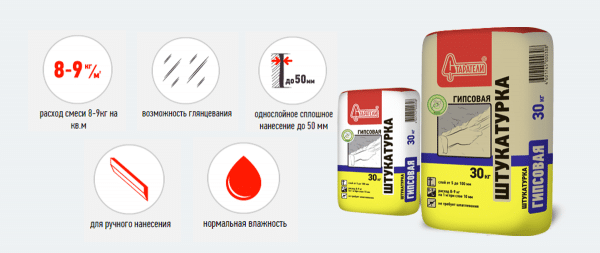
Material specifications are given below:
- approximate proportions of water and dry mix - 0.5-0.7: 1;
- consumption per 1 square. m area with a layer thickness of 1 cm - 8-10 kg;
- the life of the finished solution is 20-50 minutes;
- temperature during operation - from +5 to +30 degrees;
- adhesive force with the base - above 0.5 MPa;
- compressive strength - 2.5 MPa;
- packaging - paper bags of 15 kg, 30 kg;
- Shelf life is 6 months.
Application technology
The exact instructions for working with Prospectors are given on each package of the product. To get a high quality coating, you must strictly follow these instructions.
Surface preparation
First you need to carefully prepare the base. To do this, remove the old, peeling plaster, wipe off dirt, dust, polish the influx of building mixtures. Oil stains are washed off with solvents. Metal elements (for example, fasteners) are coated with special anticorrosive solutions so that they do not rust in the future. Otherwise, rust spots will appear through the plaster layer.
To improve the adhesion of the plaster to the base and dust removal apply 1-2 layers of primer, give it a good dry. If the surface does not absorb moisture well, use a concrete contact primer. For highly absorbent substrates, Universal Prospectors is best suited. After the composition dries up, they immediately proceed to the main stage of work.
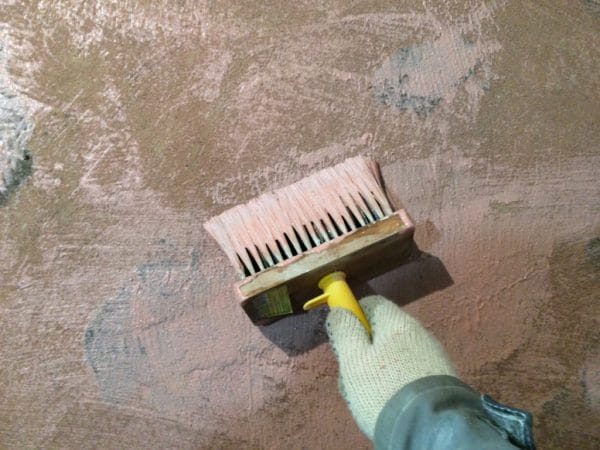
Preparation of working solution
For diluting the plaster, a large convenient container of plastic, clean water, as well as a drill with a mixer nozzle or a special construction mixer are prepared. A portion of the plaster is determined, which can be spent in half an hour, and such a volume of funds is prepared. Excesses are likely to begin to solidify and will be irrevocably damaged.
Water is poured into the container, measured strictly according to the manufacturer's recommendations. The plaster is poured into the liquid in parts, the mass is whipped with a mixer until even the smallest lumps disappear from it. After a couple of minutes, the composition is kneaded again, after which it will be ready for use. No additional components, except available, are added. The exception is dry pigment or a dye diluted with water for a decorative composition (the liquid must be included in the general norm for the dilution of plaster).
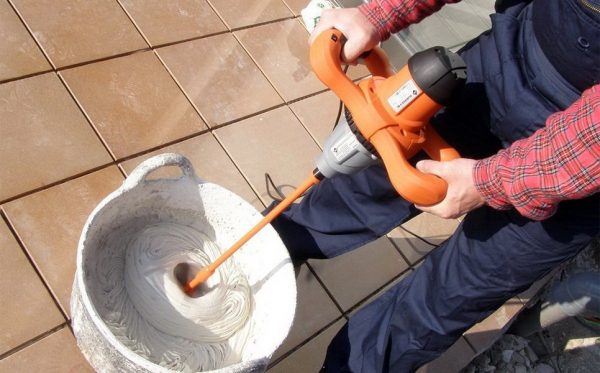
Plastering surfaces
If you plan to apply a thick layer of plaster, the surface is reinforced with a special fiberglass mesh. Reinforcement of ceilings is already carried out with a layer thickness of more than 2 cm.
Manual application
To apply the solution, use a trowel, a wide spatula and a rule. On vertical bases, apply the product in heaps on the wall, then move the tool from the bottom up. If the surface has a horizontal direction, as well as when working with the ceiling, move the trowel or putty knife to yourself, then go through the plaster layer as a rule. If you plan to apply the plaster in several layers, the first can be pulled with a notched trowel to enhance adhesion to the wall. Then the surface is in any case aligned with the rule.
40 minutes after leveling the plaster, the protruding influxes and “islands” are cut off by the same rule. The pits are filled with fresh solution, smoothed with a spatula. To prepare the base for wallpaper or painting, a fine finish is made: the building grater is wetted with water, the surface is well wiped. With high-quality mashing, the base can be not putty, but only primed.
to contents ↑
Mechanical application
To apply the mortar mechanically, you need to have a special gun. Its capacity is filled with plaster, after which the product is sprayed with strips 7 cm wide and up to 70 cm long. Each subsequent strip is slightly overlapped with the previous one. Typically, with a mechanized method, plaster the walls in only one layer.
The ceiling can also be treated with a plaster gun. Finishing begins from the side of the wall, which is at the greatest distance from the window. The higher the speed of the gun, the thinner the plaster layer will be. Do not finish the ceiling with plaster more than 2 cm, otherwise the material may peel off. After distributing the building mixture with a gun, it is leveled with a rule and a grater.
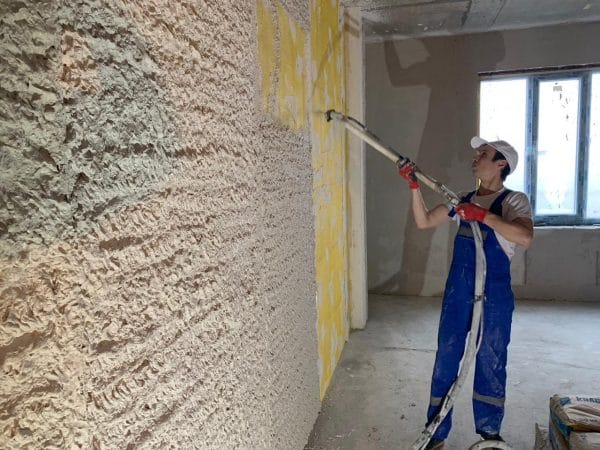
to contents ↑In the case of using a mechanized method, it is imperative to monitor compliance with safety regulations. Personal protective equipment (gloves, overalls, goggles, a respirator) will exclude damage to eyes, skin, and respiratory organs during work. You cannot ignore their use!
Advantages and disadvantages of plaster
Among the advantages of the plaster brand "Prospectors" it is worth pointing out the following:
- excellent quality, evenness, smoothness and ductility;
- ease of application on solid substrates;
- resistance to cracking, delamination during drying and during operation;
- improvement of heat-insulating characteristics of the room, noise reduction;
- the ability to fill both small bumps and deep cracks, holes;
- long service life;
- excellent tolerance of external influences;
- reasonable price, convenient packaging.
The disadvantages include a fairly large consumption of material per square meter of coverage. It will be necessary to work with gypsum plaster quickly, otherwise it will deteriorate. This point may seem difficult for beginners. Each subsequent layer should be applied only after the previous one has completely dried up, and the second layer should be thinner and lighter than the first and so on. The finish layer must be made the thinnest, otherwise it will not be durable. Such strict requirements for the methodology can also “scare” a not too experienced master.
to contents ↑
Material price
The cost of packing Stuarteli plaster is 280-350 rubles, which is a fairly affordable price for 30 kg of high-quality building mix. This material has drawbacks, but nevertheless they are blocked by its numerous advantages and excellent performance.

